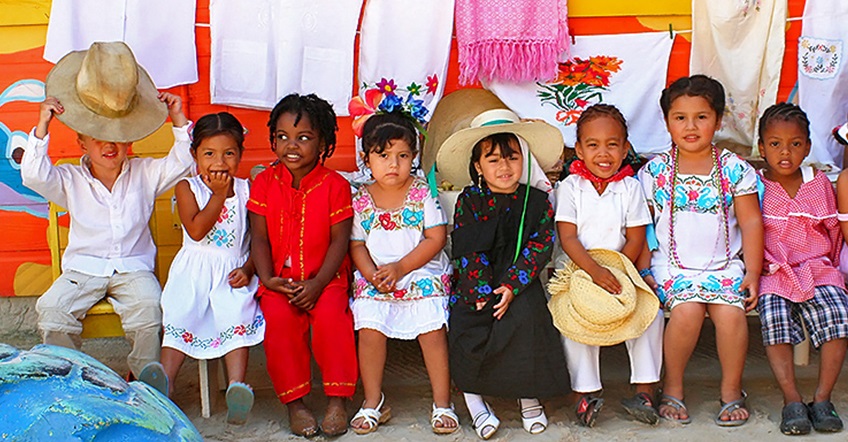Belize is a small country with only around 360,000 inhabitants, but the country has one of the most diverse populations of any country on the planet.
A truly harmonious melting pot society, the disparate ethnic and cultural groups in Belize each have their own unique culture and story of how they
came to settle in Belize.
Creole
The Creole are the largest ethnic group in Belize. Primarily descended from enslaved Africans, the Creole can be found in every district of the country.
The Creole people have been instrumental in creating some of the most iconic “Belizean” things, our native Kriol being one, this infamously quick
(everyone says it sounds like English that’s being spoken too fast) dialect has been recognized as an official language. Anyone who speaks kriol will
tell you that it’s a lot more than just broken English, there are traces of Spanish and even french in it. The food of the Creole (now
really just termed Belizean Food) is also an iconic part of the general culture of the country, most notable of which is Rice & Beans.
Garinagu
When enslaved Africans intermarried with Caribbean islanders on British-run sugar plantations, they developed the unique Garifuna culture.
After rebelling against the British, the Garifuna fled westward, eventually arriving in Belize approximately 200 years ago. They still hold true
to their traditional practices, even though they’ve adapted to speaking kriol, English, or Spanish where appropriate but speak their own Garifuna Language to
one another. The Garifuna still perform many of their traditional dances such as the Jankunu dance during Christmas, the history of which is heavily disputed
still. More popular still than the Jankunu is Punta dancing and punta music which has become very popular in some parts of Belize and the surrounding regions
even giving rise to famous “Punta Rock” artists like “Supa G” and “Lova Bway”. The Garifuna of Belize (and very much so everywhere they settle) show resilience
despite outside influences and proudly practice and display their unique “melting pot” culture.
Mestizo
Perhaps one of the most predominant of Belize cultures, the Mestizo people, were originally descended from a mix of Spanish and Mayan genetics.
The Mestizo people still hold tight to elements of both parent cultures such as their food and belief systems. Mestizo food consists of an
even-mix of Spanish tradition and Mayan ingenuity pulling elements like escabeche and Relleno soup, tortillas, corn porridge, cochinita pibil,
and tamales, to name a few. The belief system of the mestizo isn’t so even cut as the food; they adopted mainstream Christianism as their theistic
following, likely due to the Spanish influence of the conquistadores. Today, they practice most, if not all catholic Christian traditions of
the Spanish such as the daily masses, easter, day of the dead (finados), and Christmas, all celebrated with, unsurprisingly, Mayan food.
Maya
The Maya of Belize today are descended from one of three denominations of their people; Kekchi, Yucatec, and Mopan Maya. While all technically the same people,
they go so far as having different spoken languages. Though the languages are different, their social structure and theology were virtually identical.
In southern Belize, small villages of Maya people can still be found proudly embracing the ways of old. They may not revere their old pantheon anymore, nor do
they perform blood sacrifices but they are still a deeply spiritual people who hold a deep appreciation for the Earth. The “modern” Maya still perform their
celebrations and rituals to honor spirits.
Mennonites
The Mennonites of Belize are Relatively new in the bigger picture, arriving as late as the 1960’s to settle in Belize. Mennonites emigrated
from Europe in the first wave and from North America in a second wave of immigration. The Mennonites of Belize are known for their furniture
making, dairy production, and self-reliance. Unlike most other cultures and ethnic groups that populate the country, Mennonites don’t make
a habit of mixing with other Belizeans in most senses of the term. Mennonites live generally in secluded communities, not by way of distance
but by way of lifestyle since their villages and towns are inhabited almost exclusively by Mennonites.
Chinese
Originally brought to Belize as contract laborers in the 1860s, the Chinese population quickly acclimated to the country. Due to laws prohibiting them from
farming, many Chinese moved to Belize Town (now Belize City) to set up small shops and laundries. Today, the native Chinese population makes up 2% of the people in Belize.
The current generation of Asians in Belize are educated in the same schools as other Belizeans to become professionals like the general population and lead normal
lives like the rest of us and seem to bond a lot closer to Belizean locals than their parents had in the past.
East Indians
Once slavery was abolished in Belize in the 1870s, many people from British colonies in the Indian subcontinent began to emigrate to Belize. Today, they can be found
particularly in Belize City and the southern Toledo District. Today the East Indians that came all this time ago have integrated themselves in the in this network of
cultures that makes up Belize and their influences constitute a considerable part of our food culture. Though they have intermingled with the other people here, the
East Indians are still identifiable by their physical features such as facial structure and hair texture.
